Kids at schools across the state get increased access to quality health care with every new school-based health center (SBHC) and wellness center that opens.
SBHCs/WCs are usually located directly on a school campus and provide primary care like any health clinic. They are typically staffed by nurse practitioners, nurses, mental health providers, as well as part-time physicians and medical students. Services are provided at no or low cost. No one is refused service for inability to pay.
SBHCs/WCs across California provide elementary, middle, and high school students with easy access to health care. Many SBHCs/WCs also offer dental care, mental health care, leadership programs, after-school programs, and even have gardens for growing fresh produce.
Here you can see what is happening at California’s SBHCs/WCs. Don’t see your SBHC/WC? Tell us about your SBHC/WC here.
If you would like to start an SBHC at your school you can navigate our website for tools and resources to help you get started.
Take a Tour of a School-Based Health Center
Hawthorne School-Based Health Center in Oakland
La Clínica de La Raza is a Federally Qualified Health Center (FQHC) in the Bay Area that operates several school-based health centers. They created a video for students in Oakland when schools were closed during the COVID-19 pandemic so students would know what to expect when they came for a visit.
See the First School-Based Health Center in Madera County
Camarena Health partnered with Madera South High School to build the first school-based health center (SBHC) in Madera County.
The impact of having a school-based health center (SBHC) that provides counseling services, health services, and a space for young folks to engage in wellness is one that I personally would have loved to experience as a young person.
I have never been to a school that has developed such a culture of care, responsibility, and support for students that El Cerrito High has as a result of having its SBHC, The James Morehouse Project.
I’ve seen school serve as a major lifeline for students who have no social support, who don’t have a trusted adult to share their experiences, to process trauma, and gather the resources and support that they need to make it through the school day, the year, and the rest of their lives.
Photo credit: James Morehouse Project
I met a number of students supported by the SBHC since they started high school who were unable to get the support offered through other venues that they received at the SBHC. These students have been able to transform themselves and ground themselves in their own values, their own truth, and their own terms in ways I have not seen at other schools.
Even during the pandemic, I was able to maintain connections and support students as we experienced the collective trauma of quarantine and shelter in place and being removed from what often can be for many students one of the few safe spaces that they have in their day.
Serving with just a phone call, an email, a text message, or video call was appreciated by the students I worked with who often had a hard time managing the different challenges that arose at home and that became more prevalent during the quarantine.
Months into shelter in place and distance learning, we see that school-based health centers serve a vital role to continue to support students, families, and communities as we continue to face together the different challenges arising on a national level.
Programs During the Pandemic Included
- Individual counseling and crisis intervention/support, therapeutic groups (e.g. grief, social skills, BIPOC young women’s group)
- Youth development (e.g. Youth ELAC–for English language learners, Skittles for queer identified BIPOC youth, Bate Popo–for Portuguese speakers)
- Case management for young people and their families – including by supporting students/families to navigate and problem solve around the demands of distance learning and to access cash support, legal aid, food, and other resources for families facing financial crisis
- Individual and group support for teachers
- Playing a leadership role in a year-long professional development series for faculty and staff around race and equity
Shared by Gilbert Gammad, MSW Candidate, UC Berkeley
Counseling Intern at The James Morehouse Project SBHC, El Cerrito High School, Spring 2020
Kerman is a city located 15 miles outside of Fresno in California’s rural San Joaquin Valley, which is a major agricultural area. Kerman Unified opened a school-based health center (SBHC) in 2013 to serve all students at the eight schools in the district. It is operated by Valley Health Team, a local Federally Qualified Health Center (FQHC).
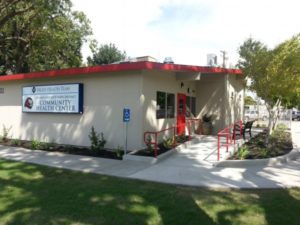 Robert Frausto, the Superintendent of Kerman Unified, said he chose the site for the SBHC strategically because the school campus is located within walking distance for all students in the district.
Robert Frausto, the Superintendent of Kerman Unified, said he chose the site for the SBHC strategically because the school campus is located within walking distance for all students in the district.
The SBHC is staffed by a full-time physician, behavioral health clinicians, and two medical assistants. It has three exam rooms for primary care services. Providers see students and community members for well-child visits, sports physicals, hearing and vision screenings, sick visits, and behavioral health, among many other services. Students have a separate entrance to the clinic and the SBHC partners with the school nurse to care for students injured while at school. Watch a video tour of the SBHC.
The behavioral health clinic provides mental health care for students – ranging from serious concerns about trauma to just needing someone to talk to. Primary care and behavioral health are integrated and the team collaborates daily to provide optimal care to patients.
In 2020, the clinic began offering drive-through COVID testing to members of the community. COVID vaccinations are also being offered at the site.
Superintendent Frausto credits the SBHC with Kerman Unified’s award-winning attendance record because it cuts down on absences that many times are caused by students missing a full day of school because of a doctor’s appointment. Those visits are now much more efficient because students do not have to leave campus.
Superintendent Frausto says his district’s solid partnership with Valley Health Team is key to the success of the SBHC in meeting the needs of the students and the community. He recalls one year when 30 kindergarten students all needed vaccinations or they would not be able to start school. He called up Valley Health Team and the immunizations were handled at the SBHC in short order.
Valley Health Team CEO Soyla Griffin says her FQHC’s mission is to do whatever it takes to keep children in the community healthy, and the SBHC is a great way to achieve that goal.
Parents also credit the SBHC with providing them with a sense of security.
“A few weeks back my daughter who attends Kerman Middle had a rapid heart rate. I brought her to a Valley Health Team clinic. The school site now has all the information so if anything should arise in the future, she can get care right away,” said a parent of a Kerman Unified student.
Take a Video Tour of the Kerman SBHC
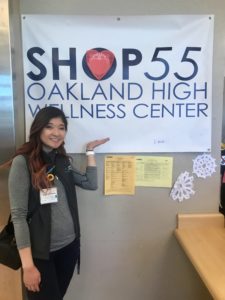
Youth Board Consultant Allison Chan, BSN, RN, PHN visits Shop 55 at Oakland High School.
By Allison Chan, BSN, RN, PHN
Shop 55 is a school-based health center located at Oakland High School in Oakland, California. Being conveniently located on campus, it allows students to easily access health services without missing school. The health center not only functions as a clinic, but also a resource hub centered around youth development and engagement.
Shop 55 is run by a partnership of a variety of agencies, including Asian American Health Services, La Clinica, Oakland Unified School District (OUSD), and East Bay Asian Youth Center (EBAYC). EBAYC is a large organization rooted in the community and supported by over 2,000 youth and family members. They develop afterschool programs, participate in civil and social engagement, tackle important topics, and work on strategies to involve officials and businesses in the community. The EBAYC Board of Directors is comprised of parents, students, neighborhoods and community members, with over half of board members being former participants of EBAYC.
Building Shop 55 stemmed from a community effort that involved students, teachers, and the entire community. Shop 55 is sustained through various city, county, and agency funding and reimbursements through MediCal. The clinic is open Tuesdays and Thursdays with doctors, nurse practitioners, school nurses, behavioral partners and medical assistants on site. The clinic provides direct medical and reproductive health services, health care case management, first aid, mobile dental, hearing, vision, individual and group counseling, and an on-call crisis counseling line. One amazing way Shop 55 has found a way to maximize their services is to provide all-over care for improving student health and academic learning – for example, if a student fails a vision or hearing exam, they are given new free glasses or given referrals for hearing aids to decrease any academic obstacles that may be present.
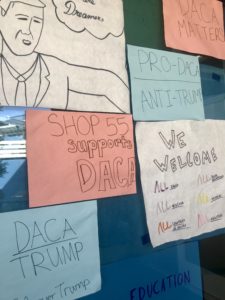
Shop 55 posters created by Oakland High students to show support for immigrant communities.
While also serving as a clinic, Shop 55 is big on youth development and engagement. They offer many opportunities for students, such as afterschool programs, academic support, enrichment programs, employment and internship positions, leadership-based research projects, and even has a Youth Advisory Board (YAB) to address various issues, advocate, and bring about awareness, change, and policy. Shop 55 at Oakland High School also has a Public Health Academy, where students learn about health careers and education from actual health professionals who teach them practical skills and expose students to the world of healthcare.
Rany Ath, Director of Shop 55, highlights the phrase “one-stop shop” to represent Shop 55. If it’s one thing she wants everyone to know, it’s that Shop 55 is a collective and collaborative effort that requires dedication, commitment, integration, partnership, and intersection in the Oakland High and Oakland community. All these qualities are embedded in their work in decreasing health barriers to achieve greater academic success and achievement, as well as decreasing the stigma of what school-based health centers are by providing a spectrum of services for youth that involves privacy and neutrality.
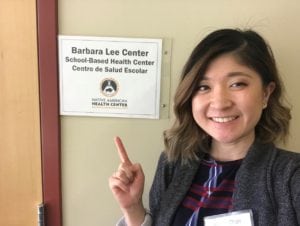
Youth Consultant Allison Chan, BSN, RN, PHN, visits the Barbara Lee Center for Health & Wellness.
By Allison Chan, BSN, RN, PHN
The Barbara Lee Center for Health & Wellness is located in the Alameda County city of San Leandro in Northern California’s Bay Area. Unlike most other school-based health centers, the Barbara Lee Center is a “school-linked health center,” which means the health center is located off campus, but also is conveniently located right across the street from San Leandro High School. Being a school-linked health center means it’s a partner with San Leandro Unified School District (SLUSD) and has the ability to serve any student within SLUSD and their direct family members.
SLUSD was the leading agency in building the Barbara Lee Center, in partnership with Native American Health Center, East Bay Asian Youth Center (EBAYC), and SLUSD health educators. The Barbara Lee Center operates five days a week and provides medical, dental, behavioral, and social services on-site with specialty services varying on specific days. Trained and licensed family nurse practitioners are on site three days a week, running four medical exam rooms providing primary care, preventative care, physical exams, medication prescriptions, and reproductive health services. Dentists and dental assistants are also on-site two days a week equipped with two brand new dental exam chairs to provide cleanings to students and family members as well. Also, instead of interns, this health center has a licensed clinical social worker.
In addition to providing direct health services, the Barbara Lee Center also provides programs geared toward youth development. For example, the Health Education Action Team (also known as HEAT), comes together to discuss weekly health topics to share with the school and San Leandro community. Students involved with HEAT organize school campaigns and workshops to bring awareness to various health concerns and highlights.
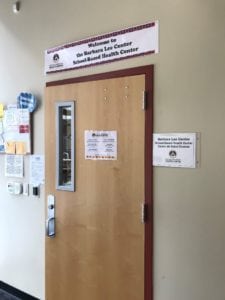 Atziri Rodriguez, the Program Manager at the Barbara Lee Wellness Center, says the success of a school-based health center relies on building relationships and making sure the clinic is integrated into the school and community. It takes time to build rapport and establish a “community” with students, administrators, and the wider community. Students and families need to feel connected to where they receive care, as that is what brings them back for well child check up and health appointments. Trust and reliability are key factors.
Atziri Rodriguez, the Program Manager at the Barbara Lee Wellness Center, says the success of a school-based health center relies on building relationships and making sure the clinic is integrated into the school and community. It takes time to build rapport and establish a “community” with students, administrators, and the wider community. Students and families need to feel connected to where they receive care, as that is what brings them back for well child check up and health appointments. Trust and reliability are key factors.
They have seen tremendous growth over the years through their variety of services for students and SLUSD community members with over 370 clients and 1,300 visits. The center hopes to increase its availability of services as the demand and need grows!
What does a coordinated system of health care look like at school?
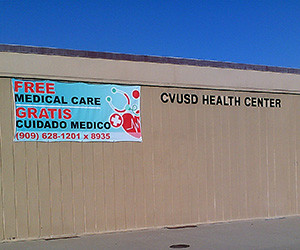 You can get a good picture from the Chino Valley Unified School District Health Center. This school-based health center (SBHC) has served over 3,000 students from 35 schools – and their families – in the past three years in a diverse community of San Bernardino County. They offer students free dental screening, physicals, vaccinations, sick care, and nutrition counseling for students and their families. They also refer students in need of mental health care to a behavioral health specialist next door.
You can get a good picture from the Chino Valley Unified School District Health Center. This school-based health center (SBHC) has served over 3,000 students from 35 schools – and their families – in the past three years in a diverse community of San Bernardino County. They offer students free dental screening, physicals, vaccinations, sick care, and nutrition counseling for students and their families. They also refer students in need of mental health care to a behavioral health specialist next door.
To get a sense of the impact, Nurse Practitioner Zahira Orioli shares Jenni’s story. Initially, a health technician at Jenni’s elementary school referred her to the SBHC because she complained she did not feel well and mentioned she had diabetes. This referral set in motion a chain of communication and practices that likely saved her life.
Jenni’s mother, Elsa, brought her to the SBHC, which conducted a full physical and medical history to get a clearer picture of Jenni’s life outside the classroom walls.
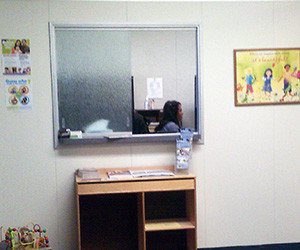 In this case, Elsa shared critical health information about Jenni, and the skilled staff knew exactly what to do. Because Jenni did not have health insurance, Elsa took Jenni to Mexico for treatment, where a doctor diagnosed her with Type 2 Diabetes and prescribed the necessary medication. However, the SBHC nurse practitioner that gave Jenni her physical recognized signs of Type 1 Diabetes instead and noted that her medicine was not making things better.
In this case, Elsa shared critical health information about Jenni, and the skilled staff knew exactly what to do. Because Jenni did not have health insurance, Elsa took Jenni to Mexico for treatment, where a doctor diagnosed her with Type 2 Diabetes and prescribed the necessary medication. However, the SBHC nurse practitioner that gave Jenni her physical recognized signs of Type 1 Diabetes instead and noted that her medicine was not making things better.
The SBHC ordered labs that confirmed the Type 1 diabetes and referred Jenni to an expert at Children’s Hospital in Orange County for further evaluation and treatment. With the proper diagnosis and referral, Jenni is now receiving the right medication and treatment.
Just as important as making the correct diagnosis was making sure Elsa and her family got connected to coverage so they could afford regular care for Jenni. Being uninsured is common in the community this school-based health center serves: more than 98% of the students served at the SBHC are from low-income families, and 82% are uninsured or underinsured. Thankfully, Chino Valley Unified School District has a Certified Enrollment Counselor who connected Elsa and her family to coverage.
This SBHC’s coordinated approach helps students, like Jenni, stay healthy so they can get back to class and succeed in school.

Setting in Raisin Fields Opens Up Health Access for Children
Students at Raisin City Elementary in Fresno County are having a healthier start to the school year thanks to a new school-based health center (SBHC). It dramatically improves access for children and families, many of whom work in the fields and used to have to drive to a clinic in the next town to get care. You can see photos here.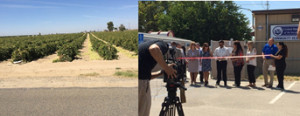
It is the first SBHC for both the Raisin City School District and the provider, United Health Centers. Our Central Valley Program Manager, Salina Mendoza, is proud to have played a role in helping both partners get a federal grant for construction, as well as helping plan how this site can best service children in the community.
The photo of the ribbon-cutting juxtaposed with the surrounding fields illustrates how this SBHC is opening up access to health care for students.



